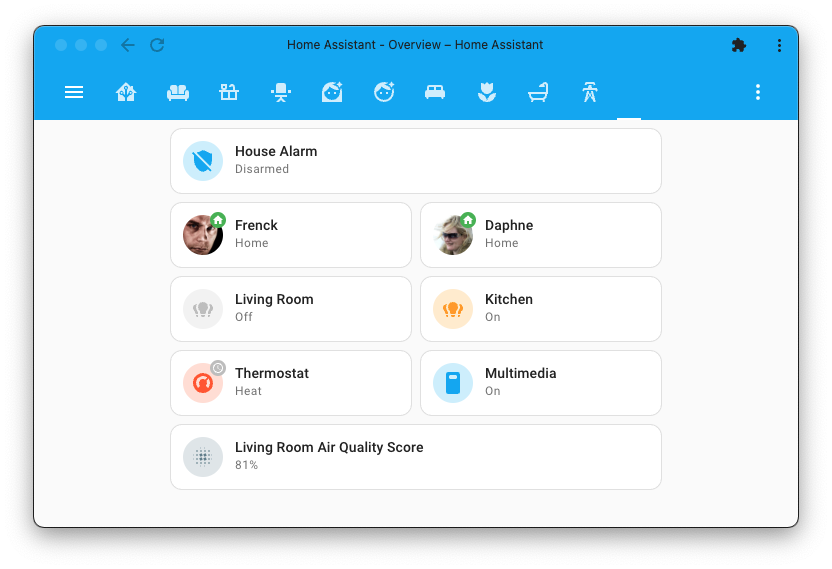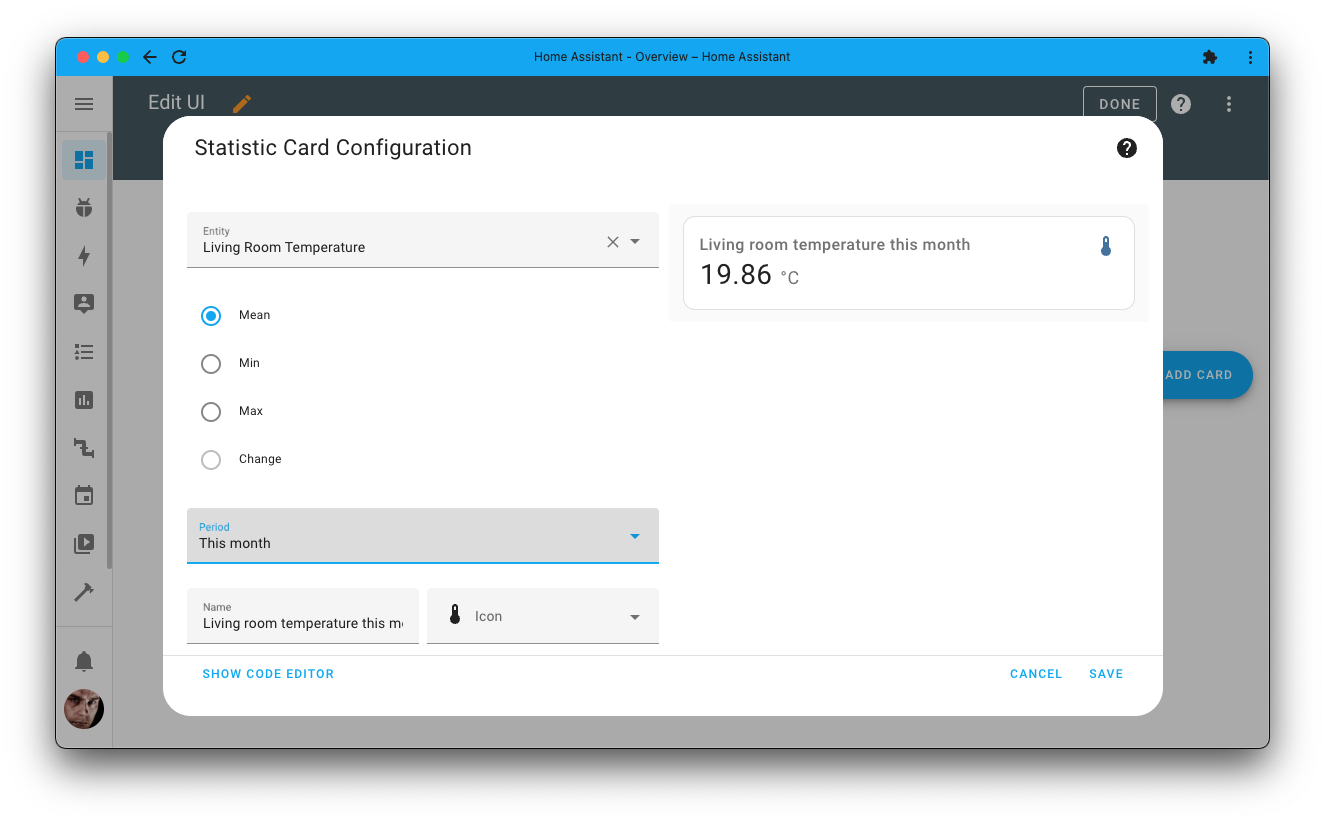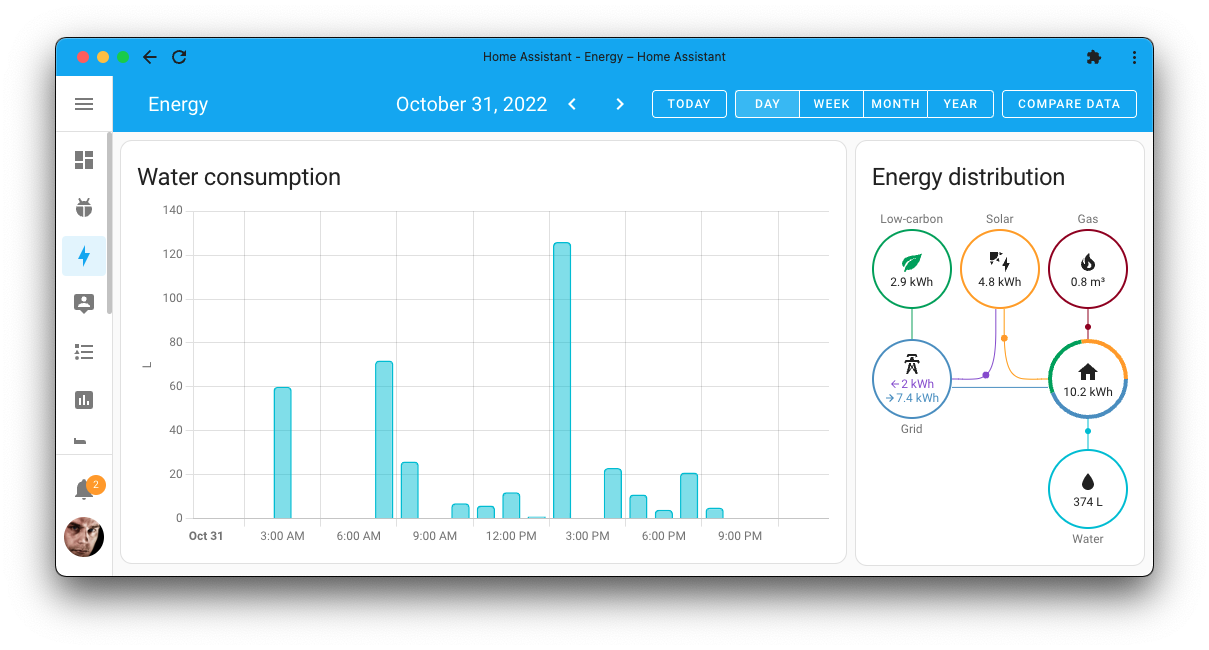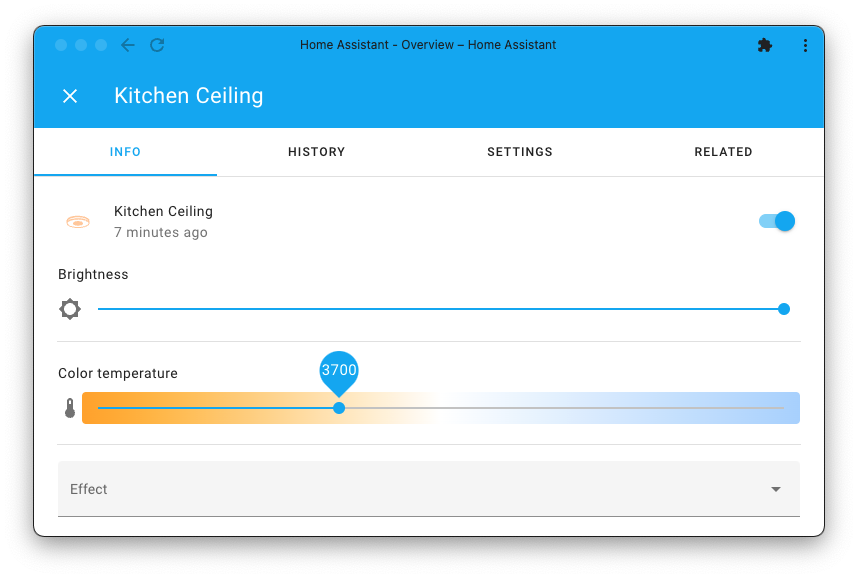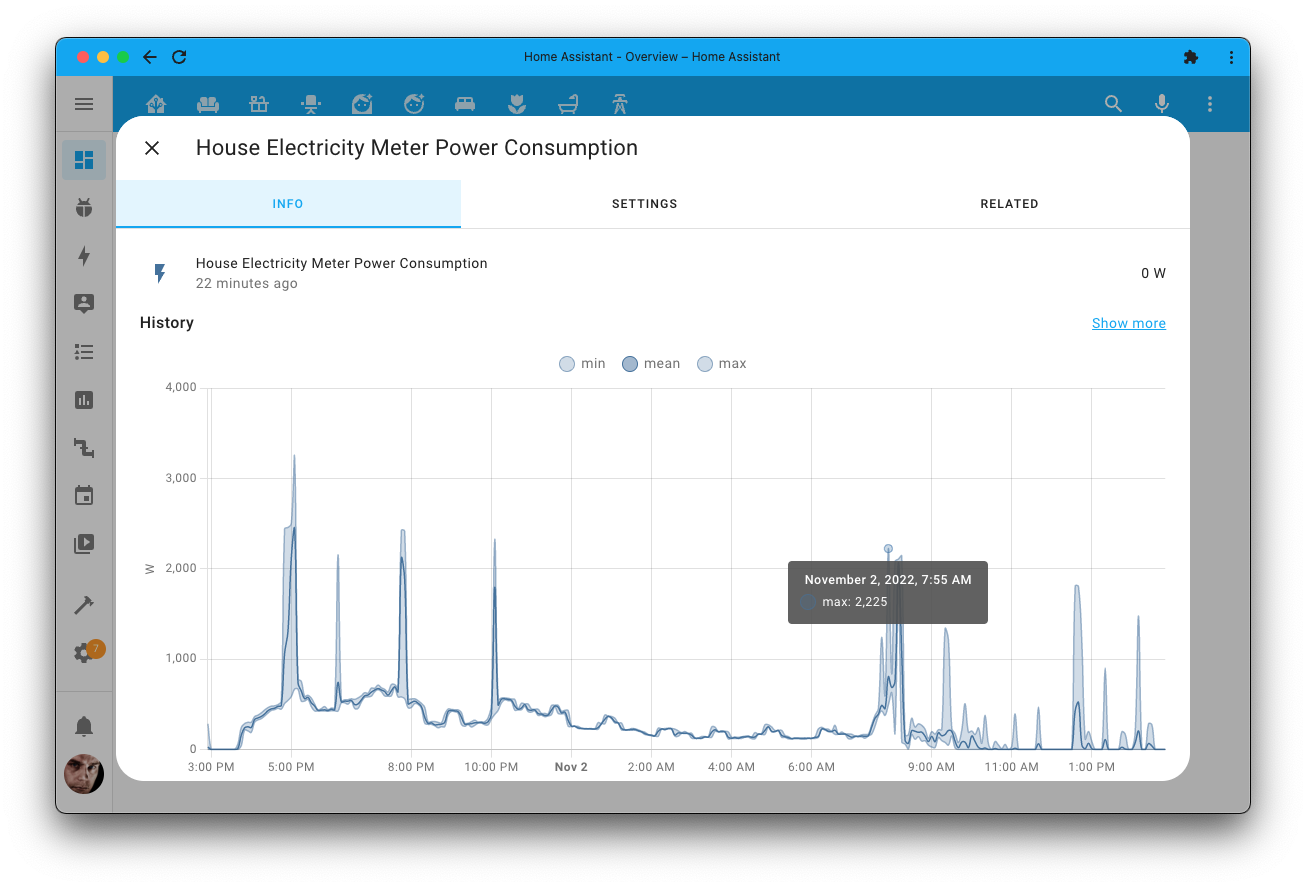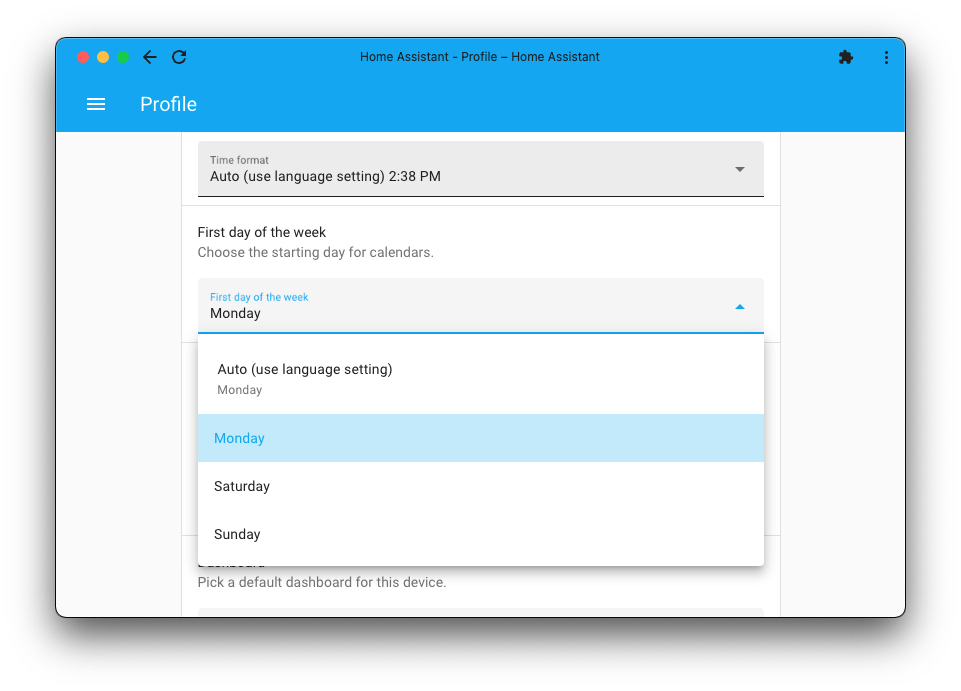Home Assistant Core 2022.11! 🎉
This November already feels a lot like Christmas 🎄, what a heck of a
release! Quite a few suggestions from the Month of “What the Heck?!”
already landed! Ready to unpack the presents? 🎁
Talking about the WTH month, it ended. Well, sort of, at least. It is now closed
for new topics/suggestions, but existing ones
remain open for discussion and can be voted on. I’m curious to see more of
these WTHs being resolved in the upcoming releases.
This release has so much goodness that I have a hard time picking a favorite.
Water usage, maybe? I’m really not sure, so I’m going to cut this intro short.
Let me know your favorite in the comments below!
Enjoy the release!
../Frenck
PS: There will be no release party live stream this month,
instead join us at the
State of the Open Home on
Sunday, November 13, 2022 (11:00 AM PST / 20:00 CET).
Índice
Tile card
This release introduces a new Dashboard card: the “Tile”!
The tile card is a lovely little card that provides a quick overview of an
entity. The icon can be tapped to toggle the entity, and the rest of the card
brings up the “more info” dialog.
Read more about the Tile card in the documentation.
This first iteration of the Tile card is one of the first cards added this
release, that brings in a new style of card into Home Assistant.
Curious to find out what else will be coming? Join us for the State
of the Open Home live stream. Go to YouTube and click the bell 🔔
so you get notified when we go live!
Statistic card
More cards! We already have the Statistics Graph card,
which can be used to display graphs of long-term statistics of an entity.
This release brings the “Statistic” card!
The “Statistic” card, as the name implies, can show a single value of an entity,
based on the long-term statistics stored of that entity.
For example, want to display the average temperature of your living room this
week on your dashboard? The average power usage of your home today? The peak
power production of your solar panels today?
Yes, all of the above, this card can do!
Read more about the Statistic card in the documentation.
Smarter reloading of automation & scripts
WTH do all automations get reloaded when you change any of them?
Good question! And that WTH topic got over 180+ votes as well!
When you change a single automation or script via the editors in the user
interface (or reload your YAML-based ones), they all get reloaded. This
means if they are running, waiting for something (a delay, an event, or for an
entity to be in a certain state for X time), they would all be reset.
This release changes this behavior, resolving that WTH! Only automations that
are actually changed are reloaded. All others will remain running and untouched.
This works when editing an automation in the UI, and even when reloading your
YAML-based automations in any split YAML setup you might have.
Oh, as an added bonus: We applied the exact same for scripts too!
Getting insights into water usage
Since Home Assistant added energy management, tracking the usage of water🚰
has been requested quite a bit. It was raised again during this month of WTH,
and with over 370 votes, it is clearly wanted a lot.
This release adds the ability to monitor your water usage in the energy dashboard!
Although water is not strictly “energy”, it is still a valuable resource
to track. It is often tightly coupled with energy usage (like gas) when using
hot water, and the gained insight can help you reduce your ecological footprint
by using less water 🌎.
Some integrations, like Flo, Flume, and
HomeWizard Energy, have been adjusted to support
tracking water. Furthermore, you can create your own using templates, MQTT,
or ESPHome (requires ESPHome version 2022.10.1 or newer).
Check out the documentation for the hardware options
available to track your water usage or how to build your own water usage
sensors.
Color temperatures in Kelvin
Another WTH topic
that was voted for almost 150 times! Why doesn’t Home Assistant use Kelvin
for color temperatures?
Well, a small piece of history: The Home Assistant story started using Philips
Hue a long, long time ago. And Hue uses mired for its color temperature,
not Kelvin.
But today, Kelvin is much more commonly used. It is even on packages of the
bulbs you buy. So, as of today, Home Assistant uses Kelvin too!
Kelvin is now the primary color temperature unit. This means all lights
and everything color temperature related shown in the user interface,
are now in Kelvin.
We still do support the good old mired. Mireds are still working and
automatically converted when needed, so this is not a breaking change 🎉
Additionally, integrations can now optionally use Kelvin directly if the
device or service accepts that. HomeKit, Shelly,
AVM FRITZ!SmartHome, and LIFX are all now using Kelvin natively.
Long-term statistics in the entity dialogs
The “more info” dialogs of entities now use long-term statistics for
the graphs shown. It makes those dialogs a lot faster, especially on
mobile devices.
The first day of the week
The start of the week can differ for many of us. Your week will start on
Saturday, Sunday, or Monday based on where you are, your locale, or maybe
personal preference. As pointed out in
this WTH topic.
Home Assistant will try to auto-detect the correct day to start the week
based on information provided by your browser. However, if it cannot detect it,
or in case you have a personal preference, you can now set it on your user profile.
You can now set the day to start the week at in your user profile.
Setting it means that all date inputs, date range pickers, schedules, calendars,
and even time conditions in automations, will take this into account when
displaying weeks.
New templating features
We also have some great new advanced features added to templating this release!
Originating from this WTH topic:
You can now use the state_attr() and states() functions as a filter,
and the is_state() and is_state_attr() functions can now be used as tests.
The average() function now accepts a default value, which can be helpful
if no average can be calculated.
Lastly, the config_entry_id() template method has been added, which allows
you to look up native IDs of integration configuration entries using one
of the entities it provides.
For more information on these new features and the Home Assistant templating
capabilities in general, check out the documentation.
Other noteworthy changes
There is much more juice in this release; here are some of the other
noteworthy changes this release:
- The default dashboard theme has been adjusted to move a little closer to the
new Material Design 3 guidelines. Borders around cards are now outlined
(instead of having a shadow), and corners are a little more rounded. - The automations and the devices dashboards now have icons on each row, making
them look all nice and shiny. Thanks, @bramkragten & @frenck. - The unit of measurement for entities providing Gas can now be changed and
converted from the UI. Thanks, @emontnemery! - Home Assistant is now discoverable via UPnP/SSDP, meaning your instance will
show up in your Windows Network. Thanks, @StevenLooman! -
Shelly Gen2 devices that sleep (battery-powered) are now supported!
Thanks, @thecode! - You can now use sensors providing Gigajoule (GJ) with the energy dashboard.
Thanks, @emontnemery! - The MQTT integration now has support for update entities! Thanks, @bieniu!
- Media player support was added to the Jellyfin integration. Thanks, @Ongy!
- The statistics card now supports “week” as a possible period. Thanks, @mib1185!
- The Sun condition can now handle setting both before & after at the same
time. Thanks, @janick! - The “forked-daapd” project was renamed to “Owntone”. The integration was now
renamed Owntone too! Thanks, @uvjustin! -
Fully Kiosk Browser now provides a service to remotely change URLs on your
wall-mounted tablet. Thanks, @cgarwood! - The Xiaomi Miio integration now supports the Xiaomi Purifier 4 Lite and
the Roborock S7 MaxV. Thanks, @alexdrl & @starkillerOG! - The UniFi integration now provides individual PoE control per port for
the client and device PoE (switches are disabled by default).
Thanks, @Kane610! - The HomeKit Controller integration now supports encrypted Bluetooth
notifications, reducing state change latency and the number of active BLE
connections made to devices. - When setting up a new Generic Camera, you will be presented with a preview
of the camera showing you if it works. Nice! Thanks, @davet2001! - Support for
unique_ids was added to the following (YAML capable) integrations:
New Integrations
We welcome the following new integrations in this release:
Integrations now available to set up from the UI
The following integrations are now available via the Home Assistant UI:
Need help? Join the community!
Home Assistant has a great community of users who are all more than willing
to help each other out. So, join us!
Our very active Discord chat server is an excellent place to be
at, and don’t forget to join our amazing forums.
Found a bug or issue? Please report it in our issue tracker,
to get it fixed! Or, check our help page for guidance for more
places you can go.
Are you more into email? Sign-up for our Building the Open Home Newsletter
to get the latest news about features, things happening in our community and
other news about building an Open Home; straight into your inbox.
Breaking Changes
Below is a listing of the breaking change for this release, per subject or
integration. Click on one of those to read more about the breaking change
for that specific item.
Multiple integrations provide sensors with the revolutions per minute unit.
Two units have been used throughout Home Assistant to indicate this:
RPM and rpm.
This release standardizes all integrations to use the lowercase rpm variant.
The following integrations have been adjusted:
Home Assistant automatically handles this change of units. However, if you
record history externally (for example, using InfluxDB), you might need to
adjust to this change.
(@epenet – #79986 #79987 #79988 #79989 #79990 #79992)
The previously deprecated YAML configuration of the Android IP Webcam
integration has been removed.
Android IP Webcam is now configured via the UI, any existing YAML
configuration has been imported in previous releases and can now be safely
removed from your YAML configuration files.
(@engrbm87 – #80875) (documentation)
The previously deprecated YAML configuration of the Anthem A/V Receivers
integration has been removed.
Anthem A/V Receivers are now configured via the UI, any existing YAML
configuration has been imported in previous releases and can now be safely
removed from your YAML configuration files.
(@gjohansson-ST – #79931) (documentation)
The UPS Last Self Test sensor is renamed to UPS Self Test Result and
a new UPS Last Self Test sensor reports time instead of the result.
You may need to replace sensor.ups_last_self_test with
sensor.ups_self_test_result in automations and scripts
referencing the sensor.ups_last_self_test entity.
(@definitio – #80773) (documentation)
The counter and remaining pages attributes of the sensors
drum remaining life, black drum remaining life, cyan drum remaining life,
magenta drum remaining life, and yellow drum remaining life have been
migrated to their own dedicated sensor entities.
If you are using these attributes in your automation or script, you will need
to adopt those for this change.
(@bieniu – #79932) (documentation)
- The
calleroption fromClickSend TTSnotify service has been removed, as
it prevented calls from being actually made. - The default name has been changed to
clicksend_ttsinstead of an empty name; otherwise
the service would appear asnotify.notify. Now it will, by default, appear
asnotify.clicksend_tts. This might impact your automation or script. - The recipient’s phone number now must match E.164 format.
(@CharlieBailly – #76669) (documentation)
The previously deprecated YAML configuration of the Coinbase
integration has been removed.
Coinbase is now configured via the UI, any existing YAML
configuration has been imported in previous releases and can now be safely
removed from your YAML configuration files.
(@epenet – #80084) (documentation)
When Darksky is configured to report in US units, the unit of measurement
for precipitation intensity has been corrected from inches to inches per hour.
(@epenet – #80611) (documentation)
Setting up the notify platform of the ecobee…
Visto en


